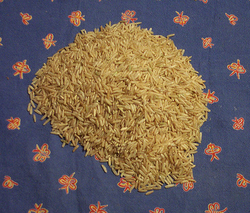(Creating new page (category taken from the one used for wholemeal grains BUT the category doesn't seem to exist yet?)) |
(Image added) |
||
| Line 1: | Line 1: | ||
Brown (wholegrain) rice is the whole natural grain, namely the unhulled, unprocessed or unmilled version of rice. It is higher in nutritional requirements for the human body but due to the fat still present in the germ, it cannot be kept as long as white rice, as the fat goes rancid. | [[File:Brownrice.png|250px|right]]Brown (wholegrain) rice is the whole natural grain, namely the unhulled, unprocessed or unmilled version of rice. It is higher in nutritional requirements for the human body but due to the fat still present in the germ, it cannot be kept as long as white rice, as the fat goes rancid. | ||
Brown rice contains all of the eight essential amino acids that promote growth and maintain life. It is a partially complete protein as it is high in methionine and low in lysine. However, if combined with beans, which have the opposite ratio, they form a complete protein. | Brown rice contains all of the eight essential amino acids that promote growth and maintain life. It is a partially complete protein as it is high in methionine and low in lysine. However, if combined with beans, which have the opposite ratio, they form a complete protein. | ||
Revision as of 00:24, 19 February 2012

Brown (wholegrain) rice is the whole natural grain, namely the unhulled, unprocessed or unmilled version of rice. It is higher in nutritional requirements for the human body but due to the fat still present in the germ, it cannot be kept as long as white rice, as the fat goes rancid.
Brown rice contains all of the eight essential amino acids that promote growth and maintain life. It is a partially complete protein as it is high in methionine and low in lysine. However, if combined with beans, which have the opposite ratio, they form a complete protein.
Brown rice is high in B vitamins in the bran, which also contains good levels of calcium and iron.
Brown rice can be purchased in long-grain and short-grain forms. The short-grain from is sweeter. The long-grain version is also known as Indica rice and is grown in India. Availability of either rice is dependent on where you live. If you wish to follow a gluten-free diet, brown rice flour and flakes are also available.
Brown rice is chewier than white rice and it has a nutty flavour.
Keeping brown rice
Due to the potential for rancidity, either consume brown rice within six months of purchase. If you wish to keep it longer, it can be frozen indefinitely.
For cooked brown rice, place in a covered, preferably airtight container and place in the refrigerator. It can be kept like this for up to one week. However, discard if it has absorbed odours or seems slimy.
Cooking a large batch of brown rice at the beginning of the week and keeping in the refrigerator to use for different meals during the week is an excellent way to overcome the concern that brown rice takes a long time to cook each time. If you cook a huge batch, place the extra in airtight containers in the freezer.
Brown rice can also be soaked before cooking to speed up its cooking time. Soak the amount you wish to cook the night before or just before going to work. Soaked brown rice should take about 20 minutes less to cook.
Cooking brown rice
- Wash the rice prior to cooking. Simply place in a colander or sieve and rinse quickly under the tap.
- Bring the water to the boil. Add the brown rice.
- Cook the brown rice over low heat until it becomes tender. It is best to cook with a lid on.